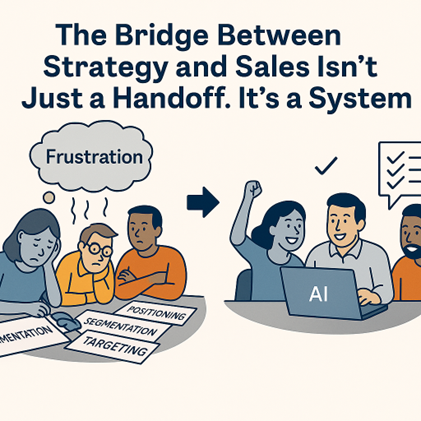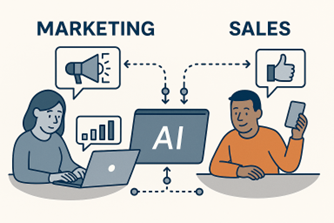If your sales team isn’t aligned to your segmentation and messaging, this article shows how AI and strategic tools can finally close the loop.
Your segmentation is strong. Your positioning is clear. Your value proposition is sharp. So why does it all seem to stall, or get diluted, once it hits the field?
We see it all the time: marketing and strategy teams put in the work to align around customer needs, but when it comes time to execute, the field team takes a different path. Not because they’re off track—but because there’s no system that truly connects upstream strategy with frontline execution. Instead of mutual reinforcement, we see missed opportunities, duplicated effort, and lots of wheel reinvention, on both sides.
The bridge between strategy and sales isn’t just a handoff. It’s a system. And with the right tools—and the power of AI—it’s finally getting the upgrade it deserves.
1. From “Sales Enablement” to Real Execution
One challenge we see often is this: marketing builds great segmentation and messaging, but the sales team doesn’t have time, tools, or context to apply it in customer conversations.
Another issue? Static collateral that quickly becomes outdated. Whether it’s a slick brochure or a fixed playbook, what sounded great in the workshop can fall flat as customer needs evolve or a new competitor enters the space.
The solution we’ve seen work again and again is simple: a segment-specific sales playbook. This isn’t just a deck. It’s a living tool that translates strategy into real-world dialogue to emphasize, what to avoid, how to tailor messages to each buyer type. And now, with AI, building that bridge is faster, smarter, and more dynamic than ever.
2. How AI + Strategic Tools Are Changing the Game
Here’s how AI, when paired with the right strategic tools, is transforming how companies close the loop between strategy and execution:
- Faster playbook creation: Once your strategy is in place, AI can rapidly generate segment-specific messaging, sample dialogue, dos and don’ts, and even visuals—without waiting weeks for content development.
- Dynamic segmentation on the fly: AI can scan account lists, websites, and public data to auto-tag accounts into segments—giving reps a head start on tailoring their approach to each customer.
- Two-way learning loops: With AI-enabled CRM systems, field notes and call reports can be summarized and synthesized to feed strategy teams real-time insight about objections, shifting priorities, or emerging trends.
3. Why This Matters: Time, Money, and Opportunity
When sales and marketing operate in silos, good insights get lost, great messaging goes unused, and time gets wasted. And when strategies are designed without input from the field, or field teams don’t see value in what’s been created, the business pays twice: once for the work done, and again for the work redone.
This isn’t a matter of one side being wrong. It’s about both sides missing out on shared value – value that can now be unlocked through a more dynamic, AI-powered system.
4. The Impact: Strategy That Evolves in Real Time
Instead of waiting for annual planning to revisit strategy, marketing and sales teams can now adapt in real time. That includes:
- Updating segmentation as customer needs evolve
- Refreshing value propositions to reflect current dynamics
- Adjusting messaging based on what’s resonating—or not—in the field
The combination of human expertise, proven strategic tools, and smart AI creates a new kind of muscle: one that turns strategy into action—and action back into insight.
The Bottom Line
Your sales team isn’t ignoring your strategy. And your marketing team isn’t out of touch. But when the two sides don’t share systems, signals, and insights, the result is inefficiency, rework, and missed impact. With AI and the right strategic tools, the bridge between marketing and sales can finally hold—and flex with the real world.

 Mary Abbazia
Mary Abbazia Tom Spitale
Tom Spitale Sean Welham
Sean Welham

